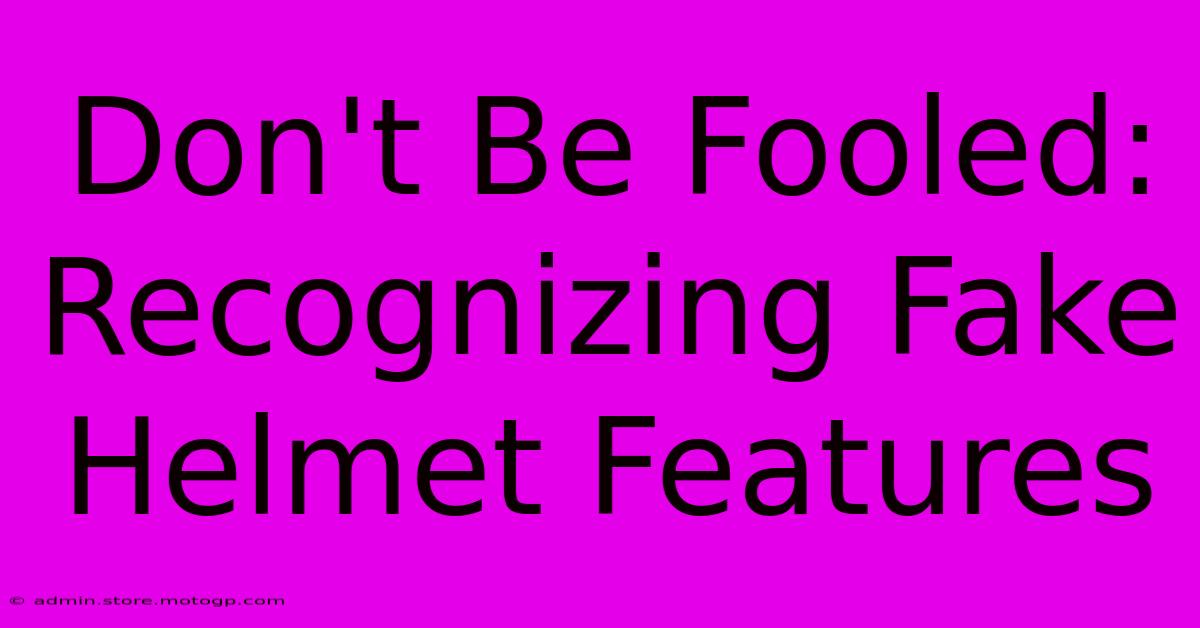Don't Be Fooled: Recognizing Fake Helmet Features

Table of Contents
Don't Be Fooled: Recognizing Fake Helmet Features
Motorcycle helmets are crucial for rider safety. A genuine helmet offers superior protection, while a counterfeit one can be dangerously inadequate. This article will help you identify fake helmet features and ensure you're investing in your safety, not a potentially deadly imitation.
Spotting the Red Flags: Identifying Fake Helmet Features
Counterfeit helmet manufacturers often cut corners, sacrificing safety for profit. Recognizing these shortcuts is key to avoiding a potentially life-threatening purchase.
1. Suspiciously Low Price:
The most significant red flag is an unrealistically low price. If a helmet that typically costs $200-$300 is being sold for $50-$100, be extremely wary. Legitimate manufacturers and retailers cannot afford to sell quality helmets at such drastically reduced prices. This low cost is often a direct indicator of inferior materials and compromised safety features.
2. Poor Quality Materials and Finish:
Examine the helmet closely. Look for inconsistencies in the paint job, rough edges, or misaligned components. Genuine helmets boast a smooth, consistent finish. Feel the helmet's shell; a flimsy or weak shell is a major warning sign. Cheap plastic and a lack of attention to detail scream "fake."
3. Missing or Incomplete Certification Labels:
All genuine helmets will carry certification labels, such as DOT (Department of Transportation) in the US, ECE 22.05 in Europe, or other relevant safety standards. The absence of these labels, or the presence of blurry, poorly printed, or oddly placed labels, is a clear sign of a counterfeit. Check that the label is correctly affixed and features all required information.
4. Vague or Missing Manufacturer Information:
Reputable manufacturers always clearly display their brand name and contact information. If you can't easily identify the manufacturer or find contact details online, proceed with caution. Fake helmets often lack this information or provide dubious contact details.
5. Inferior Straps and Fasteners:
Examine the chin strap and buckle carefully. A genuine helmet will have strong, high-quality straps and a securely functioning buckle. Weak, flimsy straps or a poorly designed buckle indicate a counterfeit helmet that may not offer adequate protection in a crash.
6. Questionable Packaging:
While not always a definitive indicator, poorly printed or damaged packaging can suggest a counterfeit product. Genuine helmets usually come in well-designed packaging with clear labeling and branding.
Where to Buy Authentic Helmets:
To ensure you're buying a genuine, safe helmet, purchase from authorized dealers and reputable retailers. Check the manufacturer's website for a list of approved retailers. Buying from unauthorized sellers significantly increases the risk of purchasing a fake helmet.
Protecting Yourself:
Investing in a quality helmet is an investment in your safety. Don't let a bargain price compromise your well-being. By carefully examining the helmet's features and purchasing from reputable sources, you can avoid the dangers of counterfeit helmets and enjoy the peace of mind that comes with knowing you're adequately protected.
Keywords:
Fake Helmet, Counterfeit Helmet, Motorcycle Helmet Safety, Helmet Certification, DOT Helmet, ECE 22.05, Authentic Helmet, Safe Helmet, Recognize Fake Helmet Features, Buy Safe Motorcycle Helmet, Motorcycle Helmet Safety Tips.

Thank you for visiting our website wich cover about Don't Be Fooled: Recognizing Fake Helmet Features. We hope the information provided has been useful to you. Feel free to contact us if you have any questions or need further assistance. See you next time and dont miss to bookmark.
Featured Posts
-
Party Like A Rockstar Austin Gp Concert
Feb 18, 2025
-
F1 Qualifying Today Track Conditions And Strategy
Feb 18, 2025
-
Experience The Moto Gp Legacy Bike For Sale
Feb 18, 2025
-
Moto2 Motorcycles The Art Of Speed
Feb 18, 2025
-
Moto Gp Arcade Game Challenge Your Friends And Family
Feb 18, 2025
